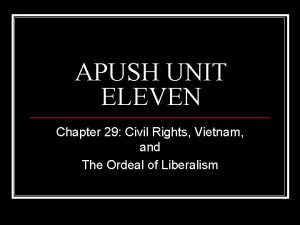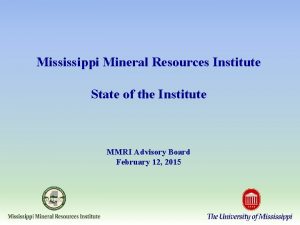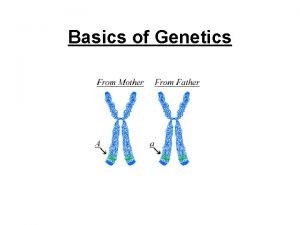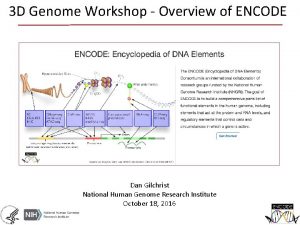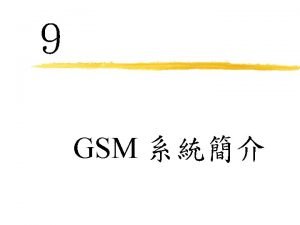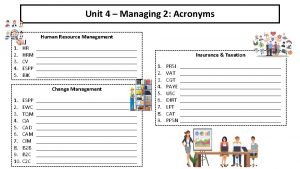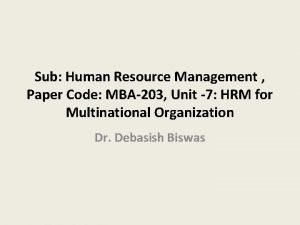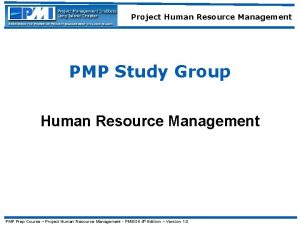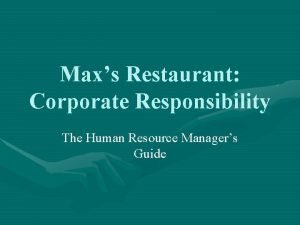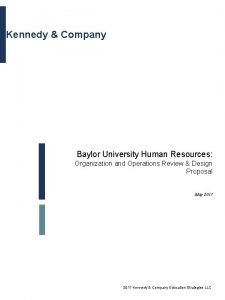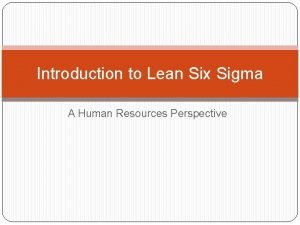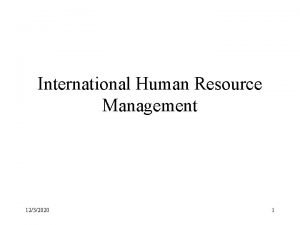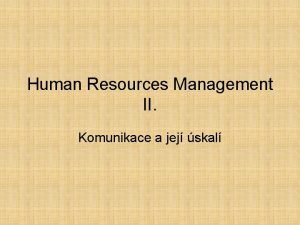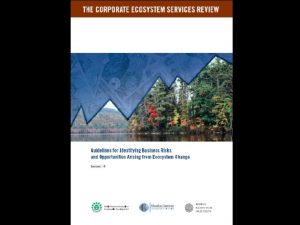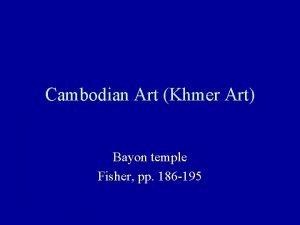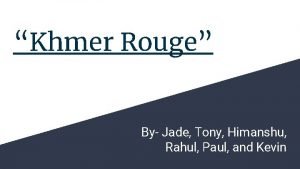INSTITUTE OF NEW KHMER Human Resources Managements Lectured




































- Slides: 36

វទយ សថ នខម រជន នថម INSTITUTE OF NEW KHMER មហ វទយ លយគរបគរងព ណជចកមម នងទ សចរណ ក រគរបគរងធនធ នមនសស Human Resources Managements Lectured by: NOUV Brosh Mobile Phone: 093640486 & E-mail: broshnouv@gmail. com HRM By: NOUV Brosh 1

Chapter 10: Employee Compensation and Benefits HRM By: NOUV Brosh 2

WHAT IS EMPLOYEE COMPENSATION? Compensation refers to all forms of financial returns and tangible services and benefits employees receive as part of an employment relationship. HRM By: NOUV Brosh 3

Total Compensation Direct Compensation Wages Salaries Commissions Bonuses Gain-sharing Fixed allowances Incentives Indirect Compensation Pay for Time Not Worked • Vacations • Breaks • Holidays Insurance Plans • Medical • Dental • Life Security Plans • Pension • Disability Insurance Employee Services • Educational Assistance • Recreational programs HRM By: NOUV Brosh 4

Components of a Total Reward System 1. Compensation Wages, Commissions and 2. Benefits Bonuses Vacations, Health 3. Social Interaction Insurance Friendly 4. Security Workplace 5. Status / Recognition Stable, Consistent Position and 6. Work Variety Rewards Respect, Prominence 7. Workload Due to Work 8. Work Importance Opportunity to Experience Different Things 9. Authority / Control / Autonomy Right Amount of Work (not too much, not 10. Advancement 11. Feedback 12. Work Conditions 13. Development too little) Is Work Valued by Society Ability to Influence Others; Control Own Destiny Chance to Get Ahead Receive Information Helping to Improve HRM By: NOUV Brosh Performance Hazard Free 5

Compensation Management and other HRM Functions HRM By: NOUV Brosh 6

OBJECTIVES OF PAY SYSTEM: • Attract and retain employees • Motivate performance • Promote skills and knowledge development • Shape corporate culture • Reinforce and define structure • Determine pay costs HRM By: NOUV Brosh 7

Pay-Design Process • Before any new compensation program is designed, there must be a clear understanding by the organization of: – its current values – its structure – its people – its goals and vision for the future HRM By: NOUV Brosh 8

Goals of Strategic Compensation Policies Motivating Value of Compensation Pay-for. Performanc e Standard Linking Compensation to Organizational Objectives HRM By: NOUV Brosh 9

Components of the Wage Mix Conditions of Labor Market Compensation Policy of Organization Area Wage Rates Cost of Living WAGE MIX Worth of Job Employee’s Relative Worth Collective Bargaining Employer’s Ability to Pay Legal Requirements HRM By: NOUV Brosh 10

Job Evaluation Systems Job Ranking Job Classification Common Methods of Job Comparison Point System Factor Comparison HRM By: NOUV Brosh 11

GENERIC TERMS USED IN COMPENSATION: • Value-added compensation refers to evaluating the individual components of the compensation program to see if they advance the needs of employees and the goals of the organization. • Pay-for-Performance Standard refers to the standard by which managers tie compensation to employee effort and performance. • Pay Equity refers an employee’s perception that compensation received is equal to the value of the work performed. • Hourly Work refers to work paid on an hourly basis. • Piecework refers to work paid according to the number of units produced. • Real Wages refers to wage increases larger than rises in the consumer price index; that is, the real earning power of wages. • Consumer Price Index (CPI) refers to the measure of the average change in prices over time in a fixed “market basket” of goods and service. • Escalator Clauses refers to clauses in the labor agreements that provide for quarterly cost-of-living adjustments in wages, basing the adjustments on changes in the consumer price index. HRM By: NOUV Brosh 12

Job Evaluation Systematic process of determining the relative worth of jobs in order to establish which jobs should be paid more than others within an organization. HRM By: NOUV Brosh 13

COMMON METHODS OF JOB COMPARSION: • Job Ranking System is the simplest and oldest system of job evaluation by which jobs are arrayed on the basis of their relative worth. • Job Classification System is the system of job evaluation by which jobs are classified and grouped according to a series of predetermined wage grades. • Point System is the quantitative job evaluation procedure that determines the relative value of a job by the total points assigned to it. • Factor Comparison System is a job evaluation system that permits the evaluation process to be accomplished on a factorby-factor basis by developing a factor comparison scale. • Hay Profile Method is a job evaluation technique using three factors – knowledge, mental activity, and accountability – to evaluate executive and. HRM managerial position. By: NOUV Brosh 14

1: Paired-Comparison Job Ranking Table Column Jobs Row Jobs Senior Administrative Secretary Administative Data-Entry Operator x Data. Processing Director File Clerk System Analyst x Programmer x Total 3 Secretary Data-Entry x 1 Operator Data. Processing x x x 5 Director File Clerk Systems 0 x x x 4 Analyst Programmer Direction: Place an X in the cell where the value of a row job is higher than that of a column job. HRM By: NOUV Brosh 2 15

2 : Points Values for Job Factors of the American Association of Industrial Management FACTORS 1 ST 2 ND 3 RD 4 TH 5 TH DEGREE DEGREE Skill 1. Job Knowledge 2. Experience 3. Initiative and ingenuity 14 28 42 56 70 22 14 44 28 66 42 88 56 110 70 Effort 4. Physical demand 10 20 30 40 50 5. Mental or visual demand 5 10 15 20 25 Responsibility 6. Equipment or press 5 10 15 20 25 7. Material or product 8. Safety of others 9. Work of others 5 5 5 10 10 10 15 15 15 20 20 20 25 25 25 10 20 30 40 50 5 10 15 20 25 Job Conditions 10. Working Conditions 11. Hazards Source : Developed by the National Metal Trades Association. Reproduced with permission of the American Association of Industrial Management, Springfield, Mass. HRM By: NOUV Brosh 16

Characteristics of Key Jobs Have importance to employees and organizations Vary in terms of job requirements Possess relatively stable job content Are used as important jobs in salary surveys HRM By: NOUV Brosh 17

The Compensation Structure Wage and Salary Surveys Issues Involved in Compensation Setting Structures Wage Curve Pay Grades Rate Ranges HRM By: NOUV Brosh 18

Wage and Salary Survey of the wages paid to employees of other employers in the surveying organization’s relevant labor market HRM By: NOUV Brosh 19

How to conduct Wage and Salary Surveys? *Select key jobs. *Determine relevant labor market. *Select organizations. *Decide on information to collect: wages/benefits/pay policies. *Compile data received. *Determine wages and benefits to pay. HRM By: NOUV Brosh 20

COMPENSATION STRUCTURE - CONTINUE � Wage Curve refers to the curve in a scattergram representing the relationship between relative worth of jobs and wage rates. � Pay Grades refers to groups of jobs within a particular class that are paid the same rate or rate range. � Red Circle Rates refers to the payment rates above the maximum of the pay range. � Skill-Based Pay refers to pay based on how many skills employees have or how many jobs they can perform. � Comparable Worth refers to the concept that male and female jobs that are dissimilar, but equal in terms of value or worth to the employer, should be paid the same. � Wage-Rate Compression refers to the compression of differentials between job classes, particularly the differential between hourly workers and their managers. HRM By: NOUV Brosh 21

What are the Universal Compensable Factors? 1. Skill: the experience, training, ability, and education required to perform a job under consideration - not with the skills an employee may possess – – – – Technical Know-how Specialized Knowledge Organizational Awareness Educational Levels Specialized Training Years of Experience Required Interpersonal Skills Degree of Supervisory Skills HRM By: NOUV Brosh 22

Universal Compensable Factors - CONTINUE 2. Effort: the measurement of the physical or mental exertion needed for performance of a job. – Diversity of Tasks – Complexity of Tasks – Creativity of Thinking – Analytical Problem Solving – Physical Application of Skills – Degree of Assistance Available HRM By: NOUV Brosh 23

Universal Compensable Factors - continue • 3. Responsibility: the extent to which an employer depends on the employee to perform the job as expected, with emphasis on the importance of job obligation. • Decision-making Authority • Scope of the organization under control • Scope of the organization impacted • Degree of integration of work with others • Impact of failure or risk of job • Ability to perform tasks without supervision. HRM By: NOUV Brosh 24

Universal Compensable Factors - CONTINUE 4. Working Conditions: • Hazards, physical surroundings of the job. • Potential Hazards Inherent in Job • Degree of Danger Which Can be Exposed to Others • Impact of Specialized Motor or Concentration Skills • Degree of Discomfort, Exposure, or Dirtiness in Doing Job Brosh HRM By: NOUV 25

WHAT IS EMPLOYEE BENEFITS? EMPLOYEE BENEFITS: that part of the total compensation package, other than pay for time worked, provided to employees in whole or in part by employer payments (e. g. , life insurance, pension, workers’ compensation, vacation). HRM By: NOUV Brosh 26

Strategic Reasons for Offering Employee Benefits: • Help attract employees • Help retain employees • Elevate the image of the organization with employees and other organizations • Increase job satisfaction HRM By: NOUV Brosh 27

Strategic considerations • Consistency of benefits package with longterm business strategy plans • Consistency of benefits with objectives of total compensation strategy • Competitive costs of benefits package • Meeting needs of company workforce • Satisfaction of legal requirements HRM By: NOUV Brosh 28

Components of benefits package • Security & health • Pay for time not worked • Employee services HRM By: NOUV Brosh 29

Payment For Time Not Worked • Paid Vacations in Cambodia: – 18 days per year in Cambodia – 30 days mandatory in Europe • Paid holidays according to Prakas. • 90 days paid maternity leave in Cambodia • Sick leave • Special leave of 7 days granted to an employee in Cambodia. HRM By: NOUV Brosh 30

Employee Wellness Programs Effort to raise overall health levels of all employees Two types of programs: • Passive • emphasis on building awareness • people identify own problems & take action • physical fitness facility program • Active • emphasis on reinforcement & support • example: outreach and follow-up model HRM By: NOUV Brosh 31

Flexible Benefits (Cafeteria) Plans Advantages – more appreciation of benefits offered – better match between benefits and employee preference – cost reduction to employee Disadvantages – increased design and start-up costs HRM By: NOUV Brosh 32

Key Issues In Benefits Planning, Design, and Administration Modifying Employee Benefits Allowing for Employee Input Providing Flexibility Communicating Benefits Information Establishing Specific Objectives HRM By: NOUV Brosh 33

Managing Benefits • Surveys and Benchmarks • Cost controls - Managed Care - Co-insurance - Employee wellness programs • Workforce Demographics • Communicating with employees • Flexible Benefit (Cafeteria) Plans HRM By: NOUV Brosh 34

EXAMPLES OF EMPLOYEE BENEFITS: Some examples of discretionary employee benefits include : • HEALTH CARE BENEFITS DEATH BENEFITS • LIFE INSURANCE (could be mandatory or compulsory if required by law) • PENSIONS • EDUCATIONAL ASSISTANCE • COMPANY LOANS • CHILD AND ELDER CARE • RECREATIONAL AND SOCIAL SERVICES • PAID VACATIONS By: NOUV Brosh 2 main concerns of management. HRM regarding EB are : Costs and Legal. 35

Reading Cases 1. Case 10 -1: The comparable Worth Debate on page 322 to 324 2. Case 11 -1: Customizing Bonus Pay Plan on page 351 to 353 3. Case 12 -1: Benefits are vanishing on page 384 to 386 HRM By: NOUV Brosh 36
 Bloody sunday apush
Bloody sunday apush Six khmer
Six khmer Khmer rouge timeline
Khmer rouge timeline Cambodian genocide scarf
Cambodian genocide scarf Sexkhmer
Sexkhmer Mon khmer
Mon khmer Empire khmer
Empire khmer Khmer empire
Khmer empire Mississippi mineral
Mississippi mineral Oregon forest resources institute
Oregon forest resources institute Transformed resources and transforming resources
Transformed resources and transforming resources Fixed resources and variable resources
Fixed resources and variable resources Renewable vs nonrenewable resources worksheet
Renewable vs nonrenewable resources worksheet National human genome research institute
National human genome research institute National human genome research institute
National human genome research institute Codom
Codom National human genome research institute
National human genome research institute Duke human vaccine institute
Duke human vaccine institute Nj institute for continuing legal education
Nj institute for continuing legal education Etsi
Etsi Wmata human resources
Wmata human resources Human resources acronyms
Human resources acronyms Gatorperks
Gatorperks Difference between hrm and hrd
Difference between hrm and hrd Resource histogram vs responsibility assignment matrix
Resource histogram vs responsibility assignment matrix Pmp roles and responsibilities
Pmp roles and responsibilities Job design continuum
Job design continuum Resource management importance
Resource management importance Recruitment process of max's restaurant
Recruitment process of max's restaurant Managing human resources in small and entrepreneurial firms
Managing human resources in small and entrepreneurial firms Empower human resources
Empower human resources Baylor university hr
Baylor university hr Human resources six sigma
Human resources six sigma Definition of human resource management
Definition of human resource management Human resources videregående uddannelser
Human resources videregående uddannelser Short term human resources
Short term human resources Historie human resources
Historie human resources
